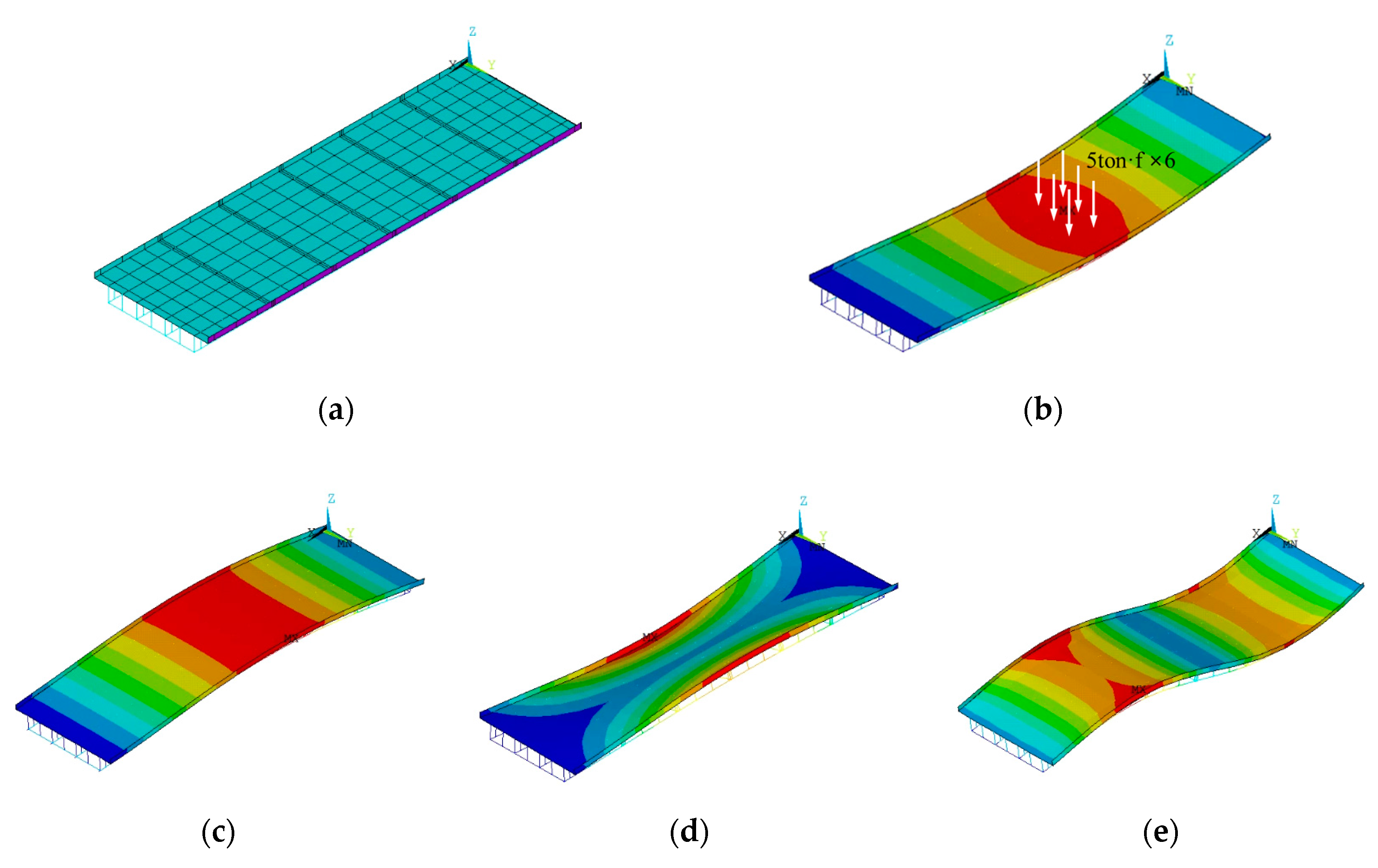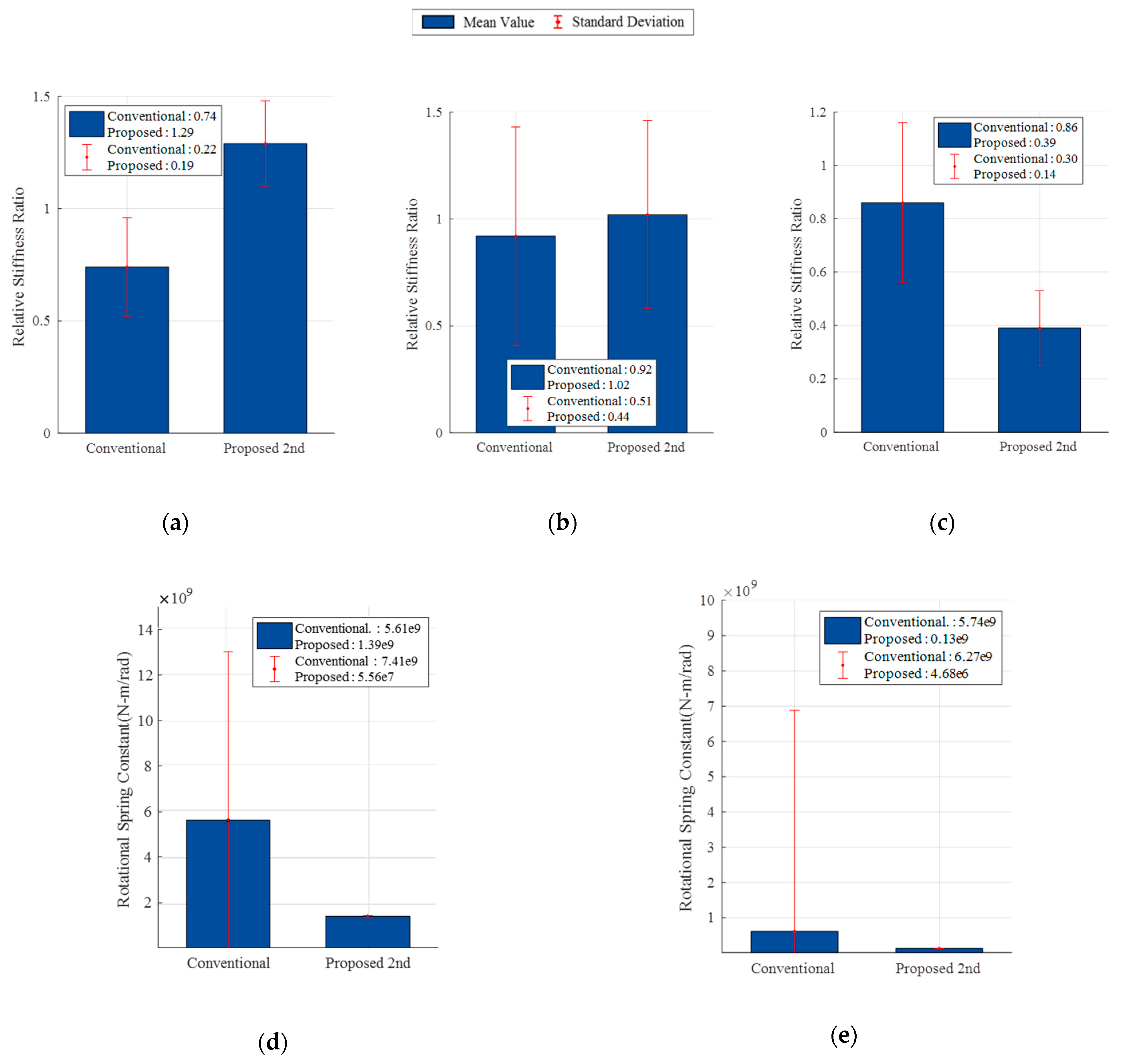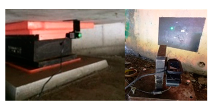A Sequential Framework for Improving Identifiability of FE Model Updating Using Static and Dynamic Data
Abstract
:1. Introduction
2. Research Backgrounds
2.1. Heterogeneous Sensor Systems for Modal and Static Data
2.2. Conventional FE Model Updating Using One-Stage Framework
2.3. Proposed FE Model Updating Using Sequential Framework
- Boundary condition identification using a neural network (N.N.) with static data (1st step): static data (i.e., displacement () and rotational angle of the support ()) is used to identify the boundary condition. The boundary condition is a model by rotational spring constant at support, and the rotational spring constant is set to represent the support condition from the movable support to fixed support. The rotational spring constant is identified using our previously proposed FEMU method [23]. To learn the relationship between the static data and support condition, the N.N. is trained with the ratio of the static data from the spring constant calculated from the initial model. Once the N.N. is trained and validated, the rotational spring constant is identified from the ratio of the measured static data the N.N. technique.
- FEMU using modal data (2nd step): Once the rotational spring constants at support are identified, FEMU using modal data is performed to identify the stiffness of the superstructure. In the second step, the identified values of the rotational spring constant are fixed during this step. The objective function in this step is shown in Table 2.
- Validity evaluation of the updated FE model using validation data: To diagnose the predictive performance of the updated FE model, it is evaluated using the validation data in the extrapolation (i.e., not used in the objective function).
3. Numerical Verification
3.1. Preliminary Work for FE Model Updating
3.2. FE Model Updating for Numerical Verification
4. Experimental Verification through a Field Test
4.1. Target Bridge and Field Experiment
4.2. Preliminary Work for Experimental Verification
4.3. FE Model Updating for Field Experimental Verification
5. Conclusions
- In the numerical study, the proposed FEMU method identified more accurate values of the updating parameters under the presence of the noise. As a result, the proposed method provided the better predictive performances over calibration and validation data than those of the conventional FEMU method.
- In the experimental verification, the conventional FEMU method generally provided larger values of the C.V. than those of the proposed FEMU methods. This large C.V. indicates a lack of the parameter identifiability due to parameter compensation. In addition, the identified values from the proposed method were more realistic than those of the conventional method (i.e., additional stiffness by the tendon in the girders).
- For calibration data in experimental verification, the proposed FEMU method provided more accurate predictions than those of the conventional FEMU method. In addition, more accurate predictions in extrapolation were also observed. This implies that the proposed FEMU method identified the accurate updating parameters and improved the static and dynamic behaviors of the existing structure.
Author Contributions
Funding
Conflicts of Interest
References
- Catbas, F.N.; Kijewski-Correa, T. Structural identification of constructed systems: Collective effort toward an integrated approach that reduces barriers to adoption. J. Struct. Eng. 2013, 139, 1648–1652. [Google Scholar] [CrossRef]
- Jin, S.S.; Jung, H.J. Sequential surrogate modeling for efficient finite element model updating. Comput. Struct. 2016, 168, 30–45. [Google Scholar] [CrossRef]
- Brownjohn, J.M.W.; Xia, P.Q. Dynamic assessment of curved cable-stayed bridge by model updating. J. Struct. Eng. 2000, 126, 252–260. [Google Scholar] [CrossRef]
- Wang, H.; Li, A.Q.; Li, J. Progressive finite element model calibration of a long-span suspension bridge based on ambient vibration and static measurements. Eng. Struct. 2010, 32, 2546–2556. [Google Scholar] [CrossRef]
- Merce, R.N.; Doz, G.N.; de Brito, J.L.V.; Macdonald, J.; Friswell, M.I. Finite element model updating of a suspension bridge using ansys software. In Proceedings of the Inverse Problems, Design and Optimization Symposium, Miami, FL, USA, 16–18 April 2007; pp. 16–18. [Google Scholar]
- Park, W.; Park, J.; Kim, H.K. Candidate model construction of a cable-stayed bridge using parameterised sensitivity-based finite element model updating. Struct. Infrastruct. Eng. 2015, 11, 1163–1177. [Google Scholar] [CrossRef]
- Zhang, Q.W.; Chang, T.Y.; Chang, C.C. Finite-element model updating for the kap shui mun cable-stayed bridge. J. Bridge Eng. 2001, 6, 285–293. [Google Scholar] [CrossRef]
- Brownjohn, J.M.W.; Moyo, P.; Omenzetter, P.; Lu, Y. Assessment of highway bridge upgrading by dynamic testing and finite-element model updating. J. Bridge Eng. 2003, 8, 162–172. [Google Scholar] [CrossRef]
- Lin, X.; Zhang, L.; Guo, Q.; Zhang, Y. Dynamic finite element model updating of prestressed concrete continuous box-girder bridge. Earthq. Eng. Eng. Vib. 2009, 8, 399–407. [Google Scholar] [CrossRef]
- Bayraktar, A.; Can Altunisik, A.; Sevim, B.; Turker, T. Finite element model updating of kömürhan highway bridge based on experimental measurements. Smart Struct. Syst. 2010, 6, 373–388. [Google Scholar] [CrossRef]
- Jin, S.S.; Cho, S.; Jung, H.J.; Lee, J.J.; Yun, C.B. A new multi-objective approach to finite element model updating. J. Sound Vib. 2014, 333, 2323–2338. [Google Scholar] [CrossRef]
- Jaishi, B.; Kim, H.J.; Kim, M.K.; Ren, W.X.; Lee, S.H. Finite element model updating of concrete-filled steel tubular arch bridge under operational condition using modal flexibility. Mech. Syst. Signal Process. 2007, 21, 2406–2426. [Google Scholar] [CrossRef]
- Lee, J.J.; Shinozuka, M. A vision-based system for remote sensing of bridge displacement. NDT E Int. 2006, 39, 425–431. [Google Scholar] [CrossRef]
- Park, Y.S.; Agbayani, J.A.; Lee, J.H.; Lee, J.J. Rotational angle measurement of bridge support using image processing techniques. J. Sens. 2016, 2016, 1923934. [Google Scholar] [CrossRef]
- Ren, W.X.; Fang, S.E.; Deng, M.Y. Response surface—Based finite-element-model updating using structural static responses. J. Eng. Mech. 2011, 137, 248–257. [Google Scholar] [CrossRef]
- Liao, J.; Tang, G.; Meng, L.; Liu, H.; Zhang, Y. Finite element model updating based on field quasi-static generalized influence line and its bridge engineering application. Procedia Eng. 2012, 31, 348–353. [Google Scholar] [CrossRef]
- Sanayei, M.; Phelps, J.E.; Sipple, J.D.; Bell, E.S. Instrumentation, nondestructive testing, and finite-element model updating for bridge evaluation using strain measurements. J. Bridge Eng. 2012, 17, 130–138. [Google Scholar] [CrossRef]
- Beven, K.; Freer, J. Equifinality, data assimilation, and uncertainty estimation in mechanistic modelling of complex environmental systems using the glue methodology. J. Hydrol. 2001, 249, 11–29. [Google Scholar] [CrossRef]
- Jung, D.S.; Kim, C.Y. Finite element model updating on small-scale bridge model using the hybrid genetic algorithm. Struct. Infrastruct. Eng. 2013, 9, 481–495. [Google Scholar] [CrossRef]
- Xiao, X.; Xu, Y.L.; Zhu, Q. Multiscale modeling and model updating of a cable-stayed bridge. Ii: Model updating using modal frequencies and in fluence lines. J. Bridge Eng. 2013, 20, 04014113. [Google Scholar] [CrossRef]
- Schlune, H.; Plos, M.; Gylltoft, K. Improved bridge evaluation through finite element model updating using static and dynamic measurements. Eng. Struct. 2009, 31, 1477–1485. [Google Scholar] [CrossRef]
- Kim, H.; Cho, S.; Sim, S.H. Data fusion of acceleration and angular velocity for improved model updating. Measurement 2016, 91, 239–250. [Google Scholar] [CrossRef]
- Park, Y.S.; Kim, S.; Kim, N.; Lee, J.J. Finite element model updating considering boundary conditions using neural networks. Eng. Struct. 2017, 150, 511–519. [Google Scholar] [CrossRef]
- Reynders, E.; Roeck, G.D. Reference-based combined deterministic–stochastic subspace identification for experimental and operational modal analysis. Mech. Syst. Signal Process. 2008, 22, 617–637. [Google Scholar] [CrossRef]
- Lee, J.; Lee, K.C.; Cho, S.; Sim, S.H. Computer vision-based structural displacement measurement robust to light-induced image degradation for in-service bridges. Sensors 2017, 17, 2317. [Google Scholar] [CrossRef]
- Park, J.; Sim, S.; Jung, H. Displacement estimation using multimetric data fusion. IEEE/ASME Trans. Mechatron. 2013, 18, 1675–1682. [Google Scholar] [CrossRef]
- Jaishi, B.; Ren, W.X. Finite element model updating based on eigenvalue and strain energy residuals using multiobjective optimisation technique. Mech. Syst. Signal Process. 2007, 21, 2295–2317. [Google Scholar] [CrossRef]
- HasançEbi, O.; Dumlupınar, T. Linear and nonlinear model updating of reinforced concrete t-beam bridges using artificial neural networks. Comput. Struct. 2013, 119, 1–11. [Google Scholar] [CrossRef]
- McCall, J. Genetic algorithms for modelling and optimisation. J. Comput. Appl. Math. 2005, 184, 205–222. [Google Scholar] [CrossRef]
- Peeters, B.; De Roeck, G. Reference-based stochastic subspace identification for output-only modal analysis. Mech. Syst. Signal Process. 1999, 13, 855–878. [Google Scholar] [CrossRef]
- Brincker, R.; Zhang, L.; Andersen, P. Modal identification of output-only systems using frequency domain decomposition. Smart Mater. Struct. 2001, 10, 441–445. [Google Scholar] [CrossRef]
- McRae, G.J.; Tilden, J.W.; Seinfeld, J.H. Global sensitivity analysis—A computational implementation of the fourier amplitude sensitivity test (fast). Comput. Chem. Eng. 1982, 6, 15–25. [Google Scholar] [CrossRef] [Green Version]












| Sensor | Specification | Performance |
|---|---|---|
 | Accelerometer (PCB 393B12, PCB Piezotronics, NY, USA) (https://www.pcb.com/products?model=393B12) | |
| Sensitivity | 10,000 mV/g | |
| Measurement range | 0.5 g·pk | |
| Frequency Range | 0.15–1000 Hz | |
 | Vision-based displacement measurement sensor [13] | |
| Measuring range | 40 m | |
| Resolution | 0.0042 mm/pixel (at 30 m) | |
| Sampling rate | 30 Hz, 60 Hz | |
 | Vision-based rotational angle measurement sensor [14] | |
| Measuring range | 40 m | |
| Resolution | 1.8 × 10−4 degree (at 30 m) | |
| Sampling rate | 30 Hz, 60 Hz | |
| Method | Date for FEMU | Objective Function | ||
|---|---|---|---|---|
| Static | Modal | |||
| Conventional method | O | O | ||
| Proposed method | 1st step | O | - | N.N. |
| 2nd step | - | O | ||
| Model | KG (Ratio (1)) | KS and KC (Ratio) | ||||||||||
|---|---|---|---|---|---|---|---|---|---|---|---|---|
| Best | Mean | C.V. | Best | Mean | C.V. | Best | Mean | C.V. | Best | Mean | C.V. | |
| Target | 3.00 × 108 | - | - | 8.00 × 109 | - | - | 0.90 | - | - | 0.80 | - | - |
| Conventional method (relative error) (2) | 3.02 × 108 (0.50%) | 2.22 × 108 (−25.86%) | 0.49 | 8.03 × 109 (0.39%) | 8.14 × 109 (1.75%) | 0.02 | 0.94 (4.74%) | 0.93 (2.91%) | 0.03 | 0.73 (−8.70%) | 0.80 (−0.05%) | 0.09 |
| Proposed Method (relative error) | 3.09 × 108 (1.17%) | 3.09 × 108 (1.17%) | 0.01 | 7.94 × 109 (−0.71%) | 7.94 × 109 (−0.71%) | 0.02 | 0.90 (−0.21%) | 0.90 (0.35%) | 0.01 | 0.80 (0.25%) | 0.80 (−0.42%) | 0.02 |
| Model | 1st Bending (Hz) | 1st Torsion (Hz) | 2nd Bending (Hz) | δC/θA (mm/rad) | δC/θB (mm/rad) |
|---|---|---|---|---|---|
| Target (before perturbed) * | 5.13 (5.14) | 5.54 (5.55) | 15.60 (15.61) | 9.80 (9.82) | 33.10 (33.11) |
| Conv. (relative error) | 5.16 (0.58%) | 5.54 (0.06%) | 15.42 (−1.15%) | 9.95 (1.53%) | 33.11 (0.03%) |
| Prop. (relative error) | 5.13 (−0.04%) | 5.54 (−0.03%) | 15.60 (−0.06%) | 9.84 (0.39%) | 33.04 (−0.18) |
| Parameter (Notation) | Change in Variable | Initial Value (Nominal Value) | Range |
|---|---|---|---|
| Rotational Spring Constant at Abutment (KA) | Linear | 1 (1 N·m/rad) | 1 × 107–1 × 1014 (Movable–Fixed) |
| Rotational Spring Constant at Pier (KP) | 1 (1 N·m/rad) | ||
| Relative Stiffness Ratio of Girder (KG) | Linear | 1 (34.13 GPa) | 0.3–2.0 |
| Relative Stiffness Ratio of Slab (KS) | Linear | 1 (34.13 GPa) | 0.3–2.0 |
| Relative Stiffness Ratio of Cross beam (KC) | Linear | 1 (34.13 GPa) | 0.3–2.0 |
© 2019 by the authors. Licensee MDPI, Basel, Switzerland. This article is an open access article distributed under the terms and conditions of the Creative Commons Attribution (CC BY) license (http://creativecommons.org/licenses/by/4.0/).
Share and Cite
Kim, S.; Kim, N.; Park, Y.-S.; Jin, S.-S. A Sequential Framework for Improving Identifiability of FE Model Updating Using Static and Dynamic Data. Sensors 2019, 19, 5099. https://doi.org/10.3390/s19235099
Kim S, Kim N, Park Y-S, Jin S-S. A Sequential Framework for Improving Identifiability of FE Model Updating Using Static and Dynamic Data. Sensors. 2019; 19(23):5099. https://doi.org/10.3390/s19235099
Chicago/Turabian StyleKim, Sehoon, Namgyu Kim, Young-Soo Park, and Seung-Seop Jin. 2019. "A Sequential Framework for Improving Identifiability of FE Model Updating Using Static and Dynamic Data" Sensors 19, no. 23: 5099. https://doi.org/10.3390/s19235099





